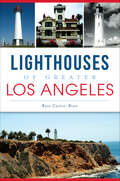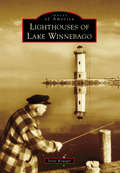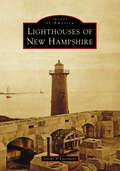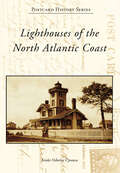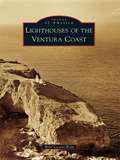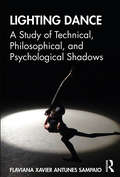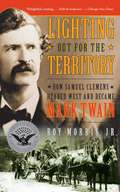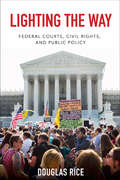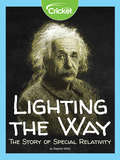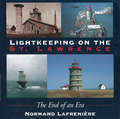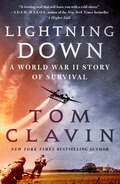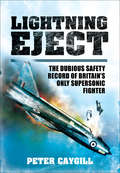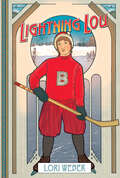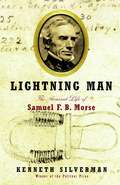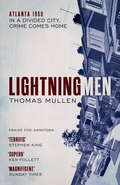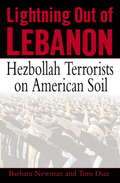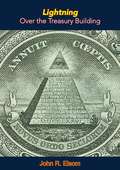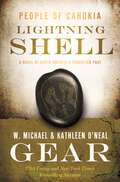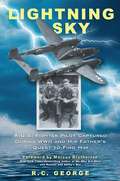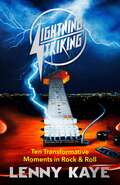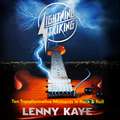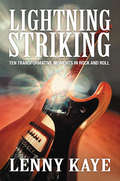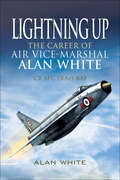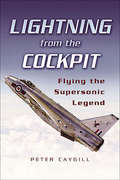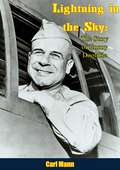- Table View
- List View
Lighthouses of Greater Los Angeles (Landmarks)
by Rose Castro-BranDespite news of shipwrecks along California's dangerous coastline, a burgeoning maritime trade came to what would become the ports of Los Angeles and Long Beach. The shipping complex became the nation's busiest, in part because of the bright navigation lights that enabled reliable access for early vessels. In 1874, sister lighthouses Point Fermin and Point Hueneme were lit on the same day, followed by the Los Angeles Harbor Lighthouse in 1913. Nicknamed the "Hollywood Lighthouse" for its frequent use in movies, in 1926, Point Vicente was established to light the Palos Verdes Peninsula. Today, they are joined by the Anacapa Island Light Station, Long Beach Light and the private aid to navigation, Lions Lighthouse for Sight. Together with the U.S. Coast Guard, these historic beacons continue to illuminate and protect the coast of Greater Los Angeles. Join author Rose Castro-Bran as she explores their storied history.
Lighthouses of Lake Winnebago (Images of America)
by Steve KruegerLake Winnebago has a rich history as a major settlement area in the Midwest, and a significant part of its times gone by involved water transportation for both commerce and passengers. Throughout its history, the 137,700-acre lake has been home to six current lighthouses, two navigation lanterns that have long disappeared from the landscape, and one that was scheduled to be built but never came to fruition. History has forgotten a few, but Lighthouses of Lake Winnebago will take you on a trip around the largest lake within Wisconsin’s borders and show you the familiar, while introducing you to the forgotten.
Lighthouses of New Hampshire (Images of America)
by Jeremy D'EntremontNew Hampshire's seacoast may be just 18 miles long, but what it lacks in length, it makes up for with centuries of fascinating maritime history. Portsmouth developed along the banks of the Piscataqua River to become the state's colonial capital and a center of trade and shipbuilding. Portsmouth Harbor's 1771 lighthouse was the first lighthouse established in the American colonies north of Boston. A few miles offshore, Native Americans were fishing and hunting at the archipelago known as the Isles of Shoals for centuries before the islands were developed by European fishermen and settlers in the 1600s, and a lighthouse was established at the southernmost island in 1821. Inland, three wooden lighthouses were built on Lake Sunapee in the late 1800s to guide steamships full of vacationers to their destinations around the lake. All of these locations have stories to tell of dedicated keepers and their families, shipwrecks, rescues, and much more.
Lighthouses of the North Atlantic Coast (Postcard History Series)
by Linda Osborne CynowaLighthouses of the North Atlantic Coast will explore many of the lighthouses and breakwater, pier, and reef lights in Maine, New Hampshire, Massachusetts, Rhode Island, Connecticut, New York, New Jersey, and Delaware. Whether it is Portland Head Lighthouse in Maine or Fenwick Island Lighthouse in Delaware, then as now, people love to visit the lights while on holiday and send postcards back home. Many of these important navigational aids are still in existence and can be visited.
Lighthouses of the Ventura Coast
by Rose Castro-BranThe Ventura County coast has been illuminated for more than a century by three distinctive lighthouses, united in their mission of warning mariners of coastal hazards and guiding ships to safe passage. Port Hueneme's original 1874 Victorian Stick Style lighthouse stood sentry until it was replaced in 1940 by the still-standing art moderne structure, which guards the only deepwater port on the California coast between San Francisco and San Pedro. The Anacapa Island Light, a cylindrical brick structure in the Channel Islands lit in 1932, was the last new lighthouse on the West Coast. Ventura, originally dubbed San Buenaventura by Fr. Junipero Serra in 1782, extends its "good fortune" to the steamers, warships, tankers, and other craft guided to safety by these navigation beacons.
Lighting Dance: A Study of Technical, Philosophical, and Psychological Shadows
by Flaviana Xavier SampaioLighting Dance pioneers the discussion of the ability of lighting design to foreground shadow in dance performances. Through a series of experiments integrating light, shadow, and improvised dance movement, it highlights and analyses what it advances as an innovative expression of shadow in dance as an alternative to more conventional approaches to lighting design. Different art forms, such as painting, film, and dance pieces from Loie Fuller, the Russell Maliphant Dance Company, Elevenplay, Pilobolus, and the Tao Dance Theater served to inspire and contextualise the study. From lighting to psychology, from reviews to academic books, shadows are examined as a symbolic and manipulative entity. The book also presents the dance solo Sombreiro, which was created to echo the experiments with light, shadow, and movement aligned to an interpretation of cultural shadow (Jung 1954, in Samuels, Shorter, and Plaut 1986; Casement 2006; Ramos 2004; Stein 2004; and others). The historical development of lighting within dance practices is also outlined, providing a valuable resource for lighting designers, dance practitioners, and theatre goers interested in the visuality of dance performances.
Lighting Out for the Territory: How Samuel Clemens Headed West and Became Mark Twain
by Roy Jr. MorrisIn the very last paragraph of Mark Twain's Adventures of Huckleberry Finn, the title character gloomily reckons that it's time "to light out for the Territory ahead of the rest." Tom Sawyer's Aunt Sally is trying to "sivilize" him, and Huck Finn can't stand it--he's been there before. It's a decision Huck's creator already had made, albeit for somewhat different reasons, a quarter of a century earlier. He wasn't even Mark Twain then, but as Huck might have said, "That ain't no matter." With the Civil War spreading across his native Missouri, twenty-five-year-old Samuel Clemens, suddenly out of work as a Mississippi riverboat pilot, gladly accepted his brother Orion's offer to join him in Nevada Territory, far from the crimsoned battlefields of war. A rollicking, hilarious stagecoach journey across the Great Plains and over the Rocky Mountains was just the beginning of a nearly six-year-long odyssey that took Samuel Clemens from St. Joseph, Missouri, to Hawaii, with lengthy stopovers in Virginia City, Nevada, and San Francisco. By the time it was over, he would find himself reborn as Mark Twain, America's best-loved, most influential writer. The "trouble," as he famously promised, had begun. With a pitch-perfect blend of appreciative humor and critical authority, acclaimed literary biographer Roy Morris, Jr., sheds new light on this crucial but still largely unexamined period in Mark Twain's life. Morris carefully sorts fact from fiction--never an easy task when dealing with Twain--to tell the story of a young genius finding his voice in the ramshackle mining camps, boomtowns, and newspaper offices of the wild and woolly West, while the Civil War rages half a continent away. With the frequent help of Twain's own words, Morris follows his subject on a winding journey of selfdiscovery filled with high adventure and low comedy, as Clemens/Twain dodges Indians and gunfighters, receives marriage advice from Brigham Young, burns down a mountain with a frying pan, gets claim-jumped by rival miners, narrowly avoids fighting a duel, hikes across the floor of an active volcano, becomes one of the first white men to try the ancient Hawaiian sport of surfing, and writes his first great literary success, "The Celebrated Jumping Frog of Calaveras County." Lighting Out for the Territory is a fascinating, even inspiring, account of how an unemployed riverboat pilot, would-be Confederate guerrilla, failed prospector, neophyte newspaper reporter, and parttime San Francisco aesthete reinvented himself as America's most famous and beloved writer. It's a good story, and mostly true--with some stretchers thrown in for good measure.
Lighting the Way: Federal Courts, Civil Rights, and Public Policy (Constitutionalism and Democracy)
by Douglas RiceDo our federal courts, including the Supreme Court, lead or merely implement public policy? This is a critical question in the study and practice of law, with a long history of continued dispute and contradictory evidence. In Lighting the Way, Douglas Rice systematically examines both sides of this debate. Introducing compelling new data on the policy focuses of federal courts, Rice presents the first long-term, comprehensive consideration of the judicial agenda. In doing so, he details the essential role of the Supreme Court and other federal courts in directing attention to issues in American politics through influential relationships with Congress, the presidency, and the public. The dynamics Rice illustrates grow from the strengths of political constituencies in various policy areas and the constitutional powers accorded to the courts. Lighting the Way provides strong evidence that, as long argued but never empirically demonstrated, the courts systematically lead the attention of other institutions on civil rights. The research speaks to a broad and growing literature in political science and sociolegal research on the interactive nature of policymaking and the critical role of legal institutions and social movements in shaping policy agendas.
Lighting the Way: The Story of Special Relativity
by Stephen WhittWhat is a light beam? What are photon particles? What are all things made of? These are questions young Einstein asked himself; questions that would change our world forever. Travel along with young Einstein to learn about his discoveries, still in motion today!
Lightkeeping on the St. Lawrence
by Normand LafreniereLightkeeping on the St. Lawrence outlines the history of lightkeeping in the St. Lawrence River and Gulf from its emergence in 1803 until automation replaced the last lightkeeper in 1988. Fog, hidden reefs, rocks, and sandbars have made the waters of the river and gulf among the most treacherous in the world. In the earliest days of lightkeeping in this region, the safety of the mariners had to be weighed against the problem of giving aid to enemy ships. With peace between French and English, safety became the overriding factor and the number of lighthouses, then light pillars and lightships, increased dramatically. <p><p> This is a tale of shipwrecks and storms, of the lonely existence of the keeper who endured harsh working conditions, often alone or with but one or two assistants. While some lighthouses offered accommodation for the keeper’s family, the occupation of lightkeeping was always one of stark isolation. <p> Based on extensive archival material and interviews with surviving lighkeepers, the book describes the onerous working day of the men of the lights, whose duties ranged from painstakingly cleaning reflectors to repeatedly sounding the fog signal on an endless night watch. It was a difficult life with scant reward, but the diligence of the keeper kept the country open to commerce in times of peace, and safe from enemy attack in times of war. <p> Published with the assistance of Parks Canada in both English and French editions, the book includes thirty-five illustrations (many in full colour), maps, and tables.
Lightning Down: A World War II Story of Survival
by Tom ClavinAn American fighter pilot doomed to die in Buchenwald but determined to survive.On August 13, 1944, Joe Moser set off on his forty-fourth combat mission over occupied France. Soon, he would join almost 170 other Allied airmen as prisoners in Buchenwald, one of the most notorious and deadly of Nazi concentration camps. Tom Clavin's Lightning Down tells this largely untold and riveting true story.Moser was just twenty-two years old, a farm boy from Washington State who fell in love with flying. During the War he realized his dream of piloting a P-38 Lightning, one of the most effective weapons the Army Air Corps had against the powerful German Luftwaffe. But on that hot August morning he had to bail out of his damaged, burning plane. Captured immediately, Moser’s journey into hell began.Moser and his courageous comrades from England, Canada, New Zealand, and elsewhere endured the most horrific conditions during their imprisonment... until the day the orders were issued by Hitler himself to execute them. Only a most desperate plan would save them.The page-turning momentum of Lightning Down is like that of a thriller, but the stories of imprisoned and brutalized airmen are true and told in unforgettable detail, led by the distinctly American voice of Joe Moser, who prays every day to be reunited with his family.Lightning Down is a can’t-put-it-down inspiring saga of brave men confronting great evil and great odds against survival.
Lightning Eject: The Dubious Safety Record of Britain's Only Supersonic Fighter
by Peter Caygill"The English Electric Lightning entered RAF squadron service in 1960 and continued flying in the interceptor role until 1988. It had a stunning world-beating performance with a top speed in excess of Mach 2 and a climb rate that would take it to 40,000 feet in a little over 3 minutes. The aircrafts safety record, however, left much to be desired. During a period in the early 1970s the attrition rate was the loss of a Lightning every month. There was a six per cent chance of a pilot experiencing an engine fire and a one in four chance that he would not survive.This book looks at Lightning accidents and incidents in chronological order using the official accident reports, Board of Inquiry findings and firsthand accounts from pilots. It puts the reader very much in the cockpit. "
Lightning Lou
by Lori WeberWhen a team in an all-girls’ hockey league comes to recruit players, twelve-year-old Lou’s dreams seem to be coming true. But the dreams hinge on one thing: never letting on that Lou is a boy. But the road to stardom is not easy, as Lou discovers that the competition is fierce, and that he’s got a lot of work to do to match the skills of the league’s star player and his chief rival, Albertine Lapensée. All the while, he has to keep his secret, and wrestle with the moral dilemma of taking a place on the team away from a deserving girl. Loosely based on a true story, Lightning Lou is a riveting and thought-provoking story for middle-grade readers.
Lightning Man: The Accursed Life of Samuel F. B. Morse
by Kenneth SilvermanIn this brilliantly conceived and written biography, Pulitzer Prize winning Kenneth Silverman gives us the long and amazing life of the man eulogized by the New York Herald in 1872 as perhaps the most illustrious American of his age. Silverman presents Samuel Morse in all his complexity. There is the gifted and prolific painter (more than three hundred portraits and larger historical canvases) and pioneer photographer, who gave the first lectures on art in America, became the first Professor of Fine Arts at an American college (New York University), and founded the National Academy of Design. There is the republican idealist, prominent in antebellum politics, who ran for Congress and for mayor of New York. But most important, there is the inventor of the American electromagnetic telegraph, which earned Morse the name Lightning Man and brought him the fame he sought. In these pages, we witness the evolution of the great invention from its inception as an idea to its introduction to the world--an event that astonished Morse's contemporaries and was considered the supreme expression of the country's inventive genius. We see how it transformed commerce, journalism, transportation, military affairs, diplomacy, and the very shape of daily life, ushering in the modern era of communication. But we discover as well that Morse viewed his existence as accursed rather than illustrious, his every achievement seeming to end in loss and defeat: his most ambitious canvases went unsold; his beloved republic imploded into civil war, making it unlivable for him; and the commercial success of the telegraph engulfed him in lawsuits challenging the originality and ownership of his invention. Lightning Man is the first biography of Samuel F. B. Morse in sixty years. It is a revelation of the life of a fascinating and profoundly troubled American genius.
Lightning Men (Darktown #Bk. 2)
by Thomas Mullen'A brilliant blending of crime, mystery, and American history. Terrific entertainment' Stephen King on DarktownLightning Men follows the multi-award-nominated, highly acclaimed crime debut Darktown into a city on the brink of huge and violent change - and full of secrets. Atlanta, 1950. Crime divides, the fight unites. Officer Denny Rakestraw and 'Negro Officers' Lucius Boggs and Tommy Smith face the Klan, gangs and family warfare in a rapidly changing Atlanta.Black families - including Smith's sister and brother-in-law - are moving into Rake's formerly all-white neighbourhood, leading his brother-in-law, a proud Klansman, to launch a scheme to 'save' their streets. When those efforts leave a man dead, Rake is forced to choose between loyalty to family or the law. Meanwhile, Boggs has outraged his preacher father by courting a domestic, whose dangerous ex-boyfriend is then released from prison. As Boggs, Smith, and their all-black precinct contend with violent drug dealers fighting for turf in new territory, their personal dramas draw them closer to the fires that threaten to consume Atlanta once again. Praise for Thomas Mullen 'Magnificent and shocking' Sunday Times'Written with a ferocious passion that'll knock the wind out of you' New York Times
Lightning Out of Lebanon: Hezbollah Terrorists on American Soil
by Tom Diaz Barbara NewmanBefore September 11, 2001, one terrorist group had killed more Americans than any other: Hezbollah, the "Party of God." Today it remains potentially more dangerous than even al Qaeda. Yet little has been known about its inner workings, past successes, and future plans--until now. Written by an accomplished journalist and a law-enforcement expert, Lightning Out of Lebanon is a chilling and essential addition to our understanding of the external and internal threats to America. In disturbing detail, it portrays the degree to which Hezbollah has infiltrated this country and the extent to which it intends to do us harm. Formed in Lebanon by Iranian Revolutionary Guards in 1982, Hezbollah is fueled by hatred of Israel and the United States. Its 1983 truck-bomb attack against the U.S. Marine barracks in Beirut killed 241 soldiers--the largest peacetime loss ever for the U.S. military--and caused President Reagan to withdraw all troops from Lebanon. Since then, among other atrocities, Hezbollah has murdered Americans at the U.S. embassy in Lebanon and the Khobar Towers U.S. military housing complex in Saudi Arabia; tortured and killed the CIA station chief in Beirut; held organizational meetings with top members of al Qaeda-including Osama bin Laden-and established sleeper cells in the United States and Canada. Lightning Out of Lebanon reveals how, starting in 1982, a cunning and deadly Hezbollah terrorist named Mohammed Youssef Hammoud operated a cell in Charlotte, North Carolina, under the radar of American intelligence. The story of how FBI special agent Rick Schwein captured him in 2002 is a brilliantly researched and written account. Yet the past is only prologue in the unsettling odyssey of Hezbollah. Using their exclusive sources in the Middle East and inside the U.S. counterterrorism establishment, the authors of Lightning Out of Lebanon imagine the deadly future of Hezbollah and posit how best to combat the group which top American counterintelligence officials and Senator Bob Graham, vice-chairman of the Senate Intelligence Committee, have called "the A Team of terrorism."
Lightning Over the Treasury Building: An Expose Of Our Banking And Currency Monstrosity, America's Most Reprehensible And Un-american Racket
by John R. ElsomA clear and concise treatise of the banking and money system of the United States as manipulated by the international bankers, by whom governments are controlled, wars promoted, peoples exploited and the real wealth of the nation gathered unto themselves through the process of mortgage and foreclosure—together with a constitutional remedy for our national dilemma.
Lightning Shell: A People of Cahokia Novel (North America's Forgotten Past #27)
by W. Michael Gear Kathleen O'Neal GearLightning Shell marks the dramatic conclusion to the People of Cahokia sub-series by bestselling authors W. Michael and Kathleen O'Neal Gear.Spotted Wrist’s squadrons are about to launch an assault on Evening Star Town. Meanwhile, the new Keeper’s loyal squadrons have taken control of central Cahokia.Blue Heron’s enemies have declared her dead, a supposed victim of the fire that consumed her palace. She’s alive and in the end it will be her wits, Seven Skull Shield’s licentious cunning, and a desperate gamble that determine who lives and who dies in Cahokia.Meanwhile, in the distant east, a desperate three-way race is underway. Walking Smoke—the Lightning Shell witch—hastens to make his way back to Cahokia, understanding that the cure for his impotence lies atop Morning Star’s Mound.Night Shadow Star means to stop him before he can get to Morning Star. Following in her wake, Fire Cat is merciless. He will stop at nothing to ensure that it is he, not Night Shadow Star, who pays the ultimate price.The final showdown will shake Cahokia to its roots, and nothing will be the same again.At the Publisher's request, this title is being sold without Digital Rights Management Software (DRM) applied.
Lightning Sky: A U.S. Fighter Pilot Captured during WWII and His Father's Quest to Find Him
by R.C. GeorgeA U.S. fighter pilot captured by the enemy. A father determined to rescue his son. One of the most remarkable and moving true stories of faith and perseverance to come out of World War II. October 6, 1944. Twenty-year-old Army Air Corps Second Lieutenant David “Mac” Warren MacArthur was on a strafing mission over Greece when a round of 88-mm German anti-aircraft flak turned his P-38 Lightning into a comet of fire and smoke. Dave parachuted to safety as the Lightning lived up to her name and struck the Adriatic Sea like a bolt of flames. In minutes, he was plucked from the water—only to find himself on the wrong end of a German rifle pointing straight at his head. Dave’s father, Lieutenant Colonel Vaughn MacArthur, was a chaplain with the 8th Armored Division of Patton’s Third Army when he learned of his son’s capture. He made it his personal mission to find him. For the duration of the war, as Dave was shuttled from camp to camp—including Dachau—his father never stopped searching. Then in May 1945, Vaughn’s last hope was Stalag VII-A in Moosburg, Germany. Through the barbed wire fence, he cried out his son’s name. Incredibly, out of tens of thousands of POWs, one of them, squinting into the sunlight, turned and smiled. Father and son spent the next two weeks together celebrating, a forever cherished memory. Over the next twenty-five years, Dave would go on to honor his father on rescue missions of his own, becoming a highly decorated and genuine American war hero. In both Korea and Vietnam, Dave would carry with him the legacy of a great man who gave everything to save his son. An inspiring, harrowing, and unforgettable chronicle of love of family and love of country, Lightning Sky is a timeless testament to extraordinary lives in extraordinary times.
Lightning Striking
by Lenny Kaye'A true testimonial and epic love letter to the soul saving power of rock & roll . . . Read it and be inspired, as I was' Bobby Gillespie'Lenny Kaye has illuminated ten facets of the jewel called rock and roll from a uniquely personal and knowledgeable perspective. He draws from a lifetime of inspiration and experience. A youth plugging in his first electric guitar, a fan taking the dance floor, a propelling player, a humble guardian of history, and the writer I have always known him to be' Patti SmithMemphis, 1954. New Orleans 1957. Philadelphia 1959. Liverpool, 1962. San Francisco 1967. Detroit 1969. New York, 1975. London 1977. Los Angeles 1984 / Norway 1993. Seattle 1991.Rock and roll was birthed in basements and garages, radio stations and dance halls, in cities where unexpected gatherings of artists and audience changed and charged the way music is heard and celebrated, capturing lightning in a bottle. Musician and writer Lenny Kaye explores ten crossroads of time and place that define rock and roll, its unforgettable flashpoints, characters and visionaries, how each generation came to be, how it was discovered by the world. Whether Elvis Presley's Memphis, the Beatles' Liverpool, Patti Smith's New York or Kurt Cobain's Seattle, LIGHTNING STRIKING reveals the communal energy that creates a scene, a guided tour inside style and performance, to see who's on stage, along with the movers and shakers, the hustlers and hangers-on, and why everybody is listening. Grandly sweeping and minutely detailed, informed by Kaye's acclaimed knowledge and experience as a working musician, LIGHTNING STRIKING is an ear-opening insight into our shared musical and cultural history, a carpet ride of rock and roll's most influential movements and moments.
Lightning Striking
by Lenny KayeMemphis, 1954. New Orleans 1957. Philadelphia 1959. Liverpool, 1962. San Francisco 1967. Detroit 1969. New York, 1975. London 1977. Los Angeles 1984 / Norway 1993. Seattle 1991. <p><p>Rock and roll was birthed in basements and garages, radio stations and dance halls, in cities where unexpected gatherings of artists and audience changed and charged the way music is heard and celebrated, capturing lightning in a bottle. Musician and writer Lenny Kaye explores ten crossroads of time and place that define rock and roll, its unforgettable flashpoints, characters and visionaries, how each generation came to be, how it was discovered by the world. <p><p>Whether Elvis Presley's Memphis, the Beatles' Liverpool, Patti Smith's New York or Kurt Cobain's Seattle, LIGHTNING STRIKING reveals the communal energy that creates a scene, a guided tour inside style and performance, to see who's on stage, along with the movers and shakers, the hustlers and hangers-on, and why everybody is listening. Grandly sweeping and minutely detailed, informed by Kaye's acclaimed knowledge and experience as a working musician, LIGHTNING STRIKING is an ear-opening insight into our shared musical and cultural history, a carpet ride of rock and roll's most influential movements and moments.
Lightning Striking: Ten Transformative Moments in Rock and Roll
by Lenny Kaye“We have performed side-by-side on the global stage through half a century…. In Lightning Striking, Lenny Kaye has illuminated ten facets of the jewel called rock and roll from a uniquely personal and knowledgeable perspective.” –Patti SmithAn insider’s take on the evolution and enduring legacy of the music that rocked the twentieth centuryMemphis, 1954. New Orleans 1957. Philadelphia 1959. Liverpool, 1962. San Francisco 1967. Detroit 1969. New York, 1975. London 1977. Los Angeles 1984 / Norway 1993. Seattle 1991.Rock and roll was birthed in basements and garages, radio stations and dance halls, in cities where unexpected gatherings of artists and audience changed and charged the way music is heard and celebrated, capturing lightning in a bottle. Musician and writer Lenny Kaye explores ten crossroads of time and place that define rock and roll, its unforgettable flashpoints, characters and visionaries, how each generation came to be, how it was discovered by the world. Whether describing Elvis Presley’s Memphis, the Beatles’ Liverpool, Patti Smith’s New York or Kurt Cobain’s Seattle, Lightning Striking reveals the communal energy that creates a scene, a guided tour inside style and performance, to see who’s on stage, along with the movers and shakers, the hustlers and hangers-on, and why everybody is listening. Grandly sweeping and minutely detailed, informed by Kaye’s acclaimed knowledge and experience as a working musician, Lightning Striking is an ear-opening insight into our shared musical and cultural history, a carpet ride of rock and roll’s most influential movements and moments.
Lightning Up: The Career of Air Vice-Marshal Alan White CB AFC FRAeS RAF
by Alan WhiteAlan White served in the RAF from 1953 to 1987 roughly the period of the Cold War. His introduction to flying came in his University Air Squadron. This seduced him into dropping out of University and joining the RAF. He initially had success during the piston-engine stages of his training but damage to a Vampire T11 and a bad start on the Hunter Weaponry Course set his confidence back until he recovered during service with his first Hunter Squadron. The infamous Duncan Sandys' cuts of 1957 caused the closure of his squadron and he found himself towing air-to-air gunnery targets, but luckily he was then moved to instruct on the Hunter Operational Conversion Unit where he developed his solo aerobatic display skills. He was then posted to take Hunters to Singapore and form a Squadron. He became involved with the SEATO response to assist the Thai governments request against communist insurgents from Laos and spent five months at Chiang Mai camping in a paddy field. After attending Staff College he was posted to Aden at a time of growing terrorist activity. He worked with the C-in-C, Admiral Sir Michael Le Fanu. Upon his return to the UK he trained to fly the supersonic Lightning fighter and eventually was promoted to lead a squadron. There followed a period of rapid promotion and he became Station Commander at RAF Leuchars. His later appointments as Air Commodore included Director of Operations (Air Defence), Senior Staff Officer HQ 11 Group, Air Commodore Plans at HQ Strike Command (where he assisted in the Falklands conflict) until he was promoted to his final rank and appointed Deputy Commander RAF Germany and then finally he became Commandant, RAF Staff College. His account is full of interesting flying detail and the internal workings of the RAF during those dangerous Cold War days.
Lightning from the Cockpit: Flying the Supesonic Legend (Aviation Ser.)
by Peter CaygillThe English Electric Lightning was the only single-seat supersonic interceptor fighter designed and manufactured in the UK. It saw service with the RAF in the sixties and seventies and gained a worthy reputation for its speed ( in excess of Mach 2 ) and phenomenal rate of climb. It was, however, a not entirely reliable aeroplane and over fifty were lost during its operational career. In this book, the author has gathered together 16 personal accounts of what it was like to fly the Lightning, thrilling stories that convey the immense brute power of the machine and also its many pitfalls. It will enthrall the enormous following the aircraft still enjoys. Two are now flying in South Africa and four are being restored to flight-worthy condition in the UK. To see a Lightning take off and climb vertically until it vanishes into the sky is one of the most spectacular sights in aviation.
Lightning in the Sky: The Story of Jimmy Doolittle
by Carl MannOriginally published in 1943, this is a biography of Jimmy Doolittle (1896-1993), a highly decorated officer in the United States Army Air Corps who pioneered in all phases of aeronautical achievement and commanded the Doolittle Raid on Japan during World War II.He became the first pilot to take the "blind" out of flying and complete the "outside loop", set numerous speed records, and won many racing trophies. Promoted to lieutenant general, he was also awarded the Medal of Honor for his valor and leadership as commander of the Doolittle Raid, a bold long-range retaliatory air raid on the Japanese main islands weeks after the attack on Pearl Harbor. His Tokyo flight is widely regarded as one of the coups of the Second World War.Doolittle also commanded the 12th Air Force over North Africa, the 15th Air Force over the Mediterranean, and the 8th Air Force over Europe.
